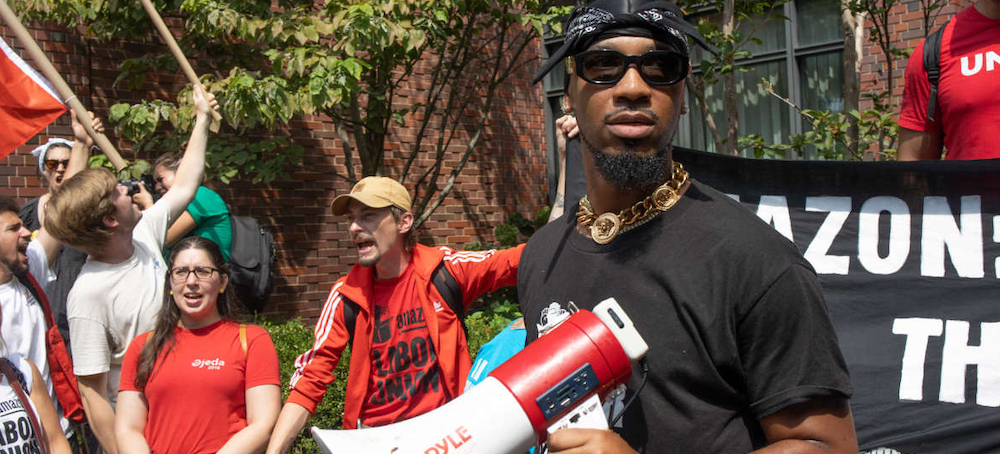If America Had Fair Laws, 60 Million Workers Would Join a Union Tomorrow
Luke Savage Jacobin Chris Smalls, a leader of the Amazon Labor Union, leads a march of Starbucks and Amazon workers and their allies to the homes of their CEOs to protest union busting in New York City. (photo: Andrew Lichtenstein/Getty Images)
Chris Smalls, a leader of the Amazon Labor Union, leads a march of Starbucks and Amazon workers and their allies to the homes of their CEOs to protest union busting in New York City. (photo: Andrew Lichtenstein/Getty Images)
According to the latest data, the ranks of unionized workers grew by 200,000 between 2021 and 2022. If the United States’ unionization rules in place weren’t so biased toward bosses, tens of millions more workers indicate they would have joined a union, too.
Driving the increase was a wave of unionization among workers of color, 231,000 more of whom now belong to unions (the number of white workers belonging to unions actually decreasing by 31,000). While 88,000 of new union jobs were added in the public sector, successful organizing in industries like entertainment, transport, and warehousing added 112,000 new union jobs in the private sector.
But in their analysis of the data, researchers at the Economic Policy Institute (EPI) explain why the new data, taken as a whole, are less than encouraging. For one thing, the economy added nonunion jobs at a greater rate than unionized ones, so the overall share of workers with union membership actually declined very slightly from 11.6 percent to 11.3 percent. Also, the raw numbers, though not insubstantial, were driven in part by unusually strong job growth that won’t necessarily persist into the coming years. Still, seen in relation to other developments such as the fifty-year high in public support for unions registered by Gallup in 2021, the data offers some evidence that a nascent fightback against the long-term decline of unionized work has begun.
But perhaps the most remarkable statistic highlighted in the EPI’s analysis concerns the number of workers who wanted to join a union in 2022 but couldn’t: some 60 million, or 48 percent of the entire nonunion workforce. It’s ironic, given the political right’s frequent justification of anti-union laws under the auspices of choice and voluntarism (evident in Orwellian phrases like “right to work”) that the appetite for union membership is so much higher than current union density would suggest. As the EPI’s researchers also pointedly note, “the large increase in the share of workers expressing a desire for unionization over the last four decades has occurred at the same time the share of workers represented by a union has declined.”
This divergence is owed, in significant part, to employer-friendly laws and regulations that make it incredibly difficult to organize a workplace even when a majority of workers might be in favor. A recent study by University of Oregon labor scholar Gordon Lafer, for example, finds that the climate facing workers at many companies effectively resembles that faced by democratic opposition movements during sham elections in one-party dictatorships. For one, existing laws governing unionization are almost comically slanted toward employers. Furthermore, when management does break the rules — employers are charged with violating federal law in more than 40 percent of union elections — penalties are often so lax that they can be treated as little more than the cost of doing business: a state of affairs that allows for rampant intimidation and election-rigging. As Lafer illustrates, using several examples from the auto industry:
[At Tesla] the Labor Board recently concluded that the company committed a series of violations, including illegally firing one union supporter and disciplining another because of their union activity; threatening employees with a loss of stock options if they joined a union; restricting employees from speaking with the media; coercively interrogating union supporters; and barring employees from distributing union information to their co-workers. So too, the CEO at Fuyao Glass — the country’s largest producer of automobile glass — was filmed openly reporting to the firm’s chairman that he had fired employees who tried to organize a union.
The decades-long decline of unionized labor, as the EPI’s analysis concludes, has thus not occurred because workers don’t want to join unions, but rather because the design of current labor law is prohibitive to forming them even when the appetite for doing so is strong. Through determination, grit, and courage, and with the winds of unusually strong job growth at their backs, hundreds of thousands of workers across America successfully joined unions last year. With more democratic labor laws in place, tens of millions more would eagerly have done the same.



